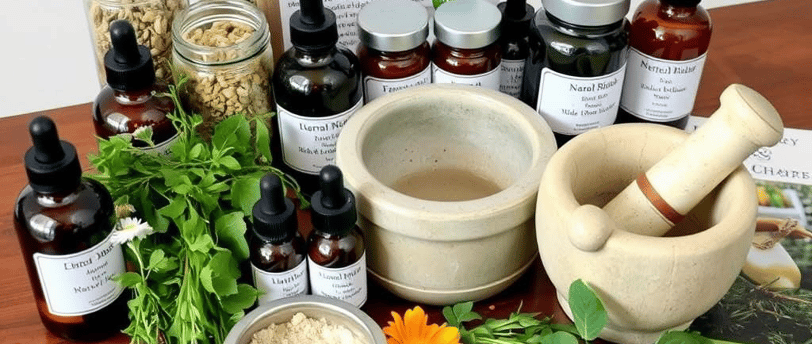Building Your Own Herbal First Aid Kit: Natural Remedies for Everyday Ailments
🌿HERBAL REMEDIES


In a world increasingly reliant on synthetic medicines, many are turning back to nature's pharmacy: herbs. Creating a well-stocked herbal first aid kit offers a powerful, natural alternative for treating minor injuries and common ailments at home, on the trail, or while traveling. Not only can it be a more sustainable and gentle approach to healing, but it also empowers you to take greater control of your health.
Here's a guide to building your own effective herbal first aid kit:
1. Understanding the Basics:
Before diving in, it's crucial to understand that herbs are powerful medicine and should be used with respect. Research each herb thoroughly before incorporating it into your kit. Consider consulting with a qualified herbalist or healthcare professional, especially if you have pre-existing medical conditions, are pregnant or breastfeeding, or are taking other medications.
2. Essential Herbs for Your Kit:
Here's a breakdown of essential herbs and their common uses in a first aid context:
Calendula (Calendula officinalis): The cornerstone of any herbal first aid kit. Calendula is a potent anti-inflammatory, antiseptic, and wound-healing herb. Use it as a salve or infused oil for cuts, scrapes, burns, insect bites, and skin irritations.
Lavender (Lavandula angustifolia): Known for its soothing and antiseptic properties. Lavender essential oil can be used topically for minor burns, insect bites, and headaches. The scent is also calming and can ease anxiety and insomnia.
Plantain (Plantago major/lanceolata): This common weed is a surprisingly powerful wound healer. Use fresh, crushed leaves as a poultice on bites, stings, splinters, and minor cuts to draw out toxins and promote healing. A plantain salve is also a great addition.
Yarrow (Achillea millefolium): An excellent styptic (stops bleeding) and antiseptic herb. Yarrow powder or tincture can be used on minor cuts and scrapes to help clot blood and prevent infection. It's also beneficial for fevers and colds when taken internally as a tea (consult a qualified practitioner).
Chamomile (Matricaria chamomilla): A gentle and calming herb, perfect for soothing upset stomachs, anxiety, and insomnia. Chamomile tea is a great remedy for children and adults alike.
Tea Tree (Melaleuca alternifolia): A potent antiseptic and antifungal essential oil. Use tea tree oil diluted in a carrier oil (like coconut or olive oil) for cuts, acne, athlete's foot, and other skin infections. Never ingest tea tree oil.
Echinacea (Echinacea purpurea): Supports the immune system and helps fight off infections. Echinacea tincture can be taken at the first sign of a cold or flu.
Peppermint (Mentha piperita): Useful for relieving nausea, indigestion, and headaches. Peppermint tea can soothe an upset stomach, while peppermint essential oil (diluted) can be used to ease tension headaches.
3. Forms and Preparations:
Herbs can be used in various forms within your first aid kit:
Dried Herbs: Versatile for making teas, infusions, and poultices.
Tinctures: Alcohol-based extracts that are potent and have a long shelf life.
Infused Oils: Herbs steeped in oil, used topically for skin conditions.
Salves: Infused oils combined with beeswax for a thicker, protective balm.
Essential Oils: Concentrated plant extracts, potent and require dilution for topical use.
Teas: Gentle and soothing for internal use.
4. Assembling Your Kit:
Choose a Container: Select a durable, waterproof container like a tackle box, tote bag, or sturdy pouch.
Include Essential Supplies: Don't forget basic first aid supplies like bandages, gauze, antiseptic wipes, tweezers, scissors, safety pins, and gloves.
Label Everything Clearly: Label each item with the herb's name, uses, and dosage instructions.
Keep it Organized: Use small bags or containers to separate herbs and supplies for easy access.
Store it Properly: Store your kit in a cool, dark, and dry place, away from direct sunlight and heat.
5. Responsible Use and Precautions:
Proper Identification: Ensure you are using the correct herb. Misidentification can lead to adverse reactions.
Dosage: Use herbs in appropriate dosages. Start small and increase gradually as needed, observing for any negative effects.
Allergies: Be aware of potential allergies. Perform a skin patch test before applying herbs topically, especially essential oils.
Interactions: Consider potential interactions with medications. If you are taking prescription drugs, consult with your doctor or a qualified herbalist before using herbs medicinally.
When to Seek Medical Attention: Herbal remedies are effective for minor ailments. However, for serious injuries or illnesses, seek professional medical care immediately.
6. Resources for Further Learning:
Reputable Herbalism Websites: Look for websites run by qualified herbalists.
Herbal Books: Consult reliable herbal guides from trusted authors.
Herbalism Courses: Consider taking an introductory herbalism course to deepen your knowledge and skills.
Conclusion:
Creating your own herbal first aid kit is a rewarding journey towards natural healing. By carefully selecting and utilizing these plant-based remedies, you can empower yourself to address minor injuries and ailments in a safe and effective way, fostering a deeper connection with the natural world and your own well-being. Remember to prioritize safety, educate yourself thoroughly, and always seek professional medical advice when necessary.
